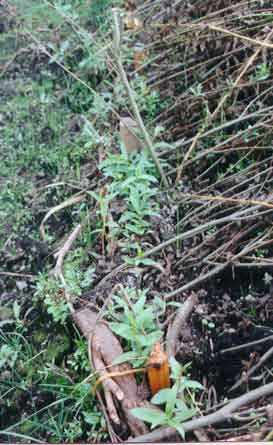Vegetative Methods
|
Initially useful to reduce surface erosion; over time to improve structural
integrity of a bank as root systems develop. Also to improve aesthetic
quality of riparian zone
Vegetative material protects the bank in several ways:
-living root systems hold soil in place, increasing overall bank stability,
-vegetation causes sediment deposition, reducing the stream sediment
load and re-establishing the streambank,
-increased roughness directs flow velocity away from the streambank and
acts as a buffer against abrasive transported materials.
|
 |
Techniques:
Herbaceous ground cover , or, grasses and forbs can provide temporary
erosion control on bare soils prior to the establishment of shrubs and trees
Live cuttings can be used to prevent erosion and allow successional
vegetation to establish. Stream banks can be replanted with willow,
cottonwood
and other native
riparian species which should be collected while dormant, (December through
MR.h or prior to bud break). Soaking the cuttings prior to installation (5-7
days) has been shown to significantly increase their survival. This initiates
the root growth process within the inner layer of bark. Cutting survival rate
is greatly reduced if they are not taken at the appropriate time. Sometimes
weather conditions are not conducive to installation of cuttings as the best
time to install them is while they are dormant in winter. Willows may need constant
managing to control invasiveness. Use stakes 3’-4’ in length and 3/4"
-2" in diameter for ease of transport and installation. Two thirds of the cutting
should be planted in the ground with one to three buds remaining above ground
level. The stakes are installed using an auger or digging bar. It is essential
to have good contact between the cutting and the soil. Air pockets around the
cutting can kill the roots, so soil should be tamped around the cutting firmly
several times as the hole is filled. If bank stabilization is the goal of the
planting, the cutting should extend more above the ground (1-2 ft.) at a 45
degree angle from the channel bottom to provide immediate protection as it leafs
out. Stakes should be planted close together (1-3 ft. apart) to form a "wall"
of protection.
Fascines or wattles are used to rapidly reestablish flatter slopes.
Bundles of live dormant cuttings can be secured in the bank or toe zone with
stakes. When installing the bundles, a trench about 4-6 inches deep may be dug
parallel to the stream or perpendicular to the stream, depending on the type
of protection needed. The wattle is placed in the trench with the ends exposed
and the rest of the wattle is covered with soil and packed down. The buried
section will sprout roots and the exposed ends will leaf out. Plants commonly
used are species which readily sprout roots and shoots such as dogwood
, willow,
and alder
. The lengths vary from 3’ to 6’ depending upon accessibility
to the site and size of area treated.
Brush mattresses are laid flat in the bank zone and secured with dead
stakes (driven 1m into the bank) and a network of wire or rope.they are best
used in areas of high water velocity and bank height greater than 2m. The mattress
consists of at least a 30cm layer of 20-50 long (1.5m) live branches per meter
of area covered. Bury the butt ends and cover entire mattress with soil.

Brush layers are a less labour intensive technique that can be employed
in areas of low energy. Live loose cuttings or rooted stock is placed in successive
horizontal rows dug into the bank zone parallel to the stream. Erosion protection
is minimal until the herbaceous cover develops. Toe protection requirements
must therefore be evaluated and a more integrated method may be useful.
Advantages of vegetative methods
-cost effective and self-maintaining (or requiring little attention once established)
-bank structural integrity is increased over time as root systems develop
-as plant growth increases, overhanging vegetation shades the stream channel
and decreases water temperature
-leaf litter from planted sites provides an influx of nutrients to the stream
cycle
-over time will result in creation of habitat through windfall of logs
Disadvantages of vegetative methods
- to create in-stream habitat, vegetative methods need to be combined
with boulders, woody debris, and undercuts
- need to consider soil characteristics, and use native plants specific to
the site
- site may need to be fenced off to protect plants from animal browse and foot
traffic
-vegetative techniques are not recommended for steep entrenched costal streams
© 2009 Veins of Life
Watershed Society / All Rights Reserved / if you wish to use any info for commercial
or non commercial usage you must obtain permissions from The Veins of Life
Watershed Society

